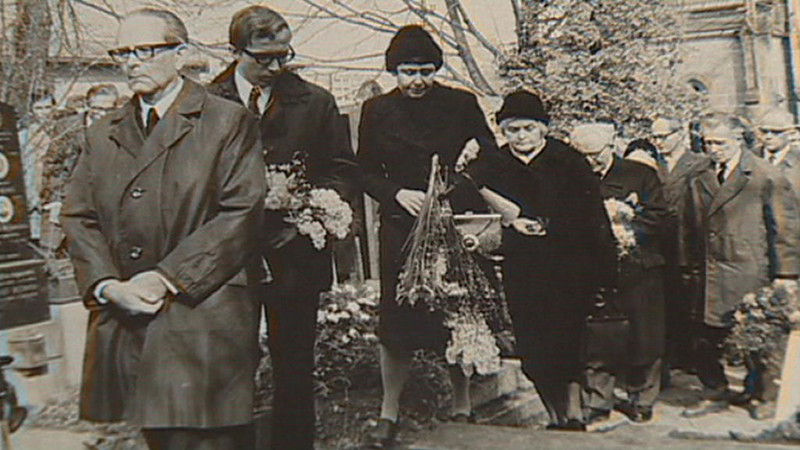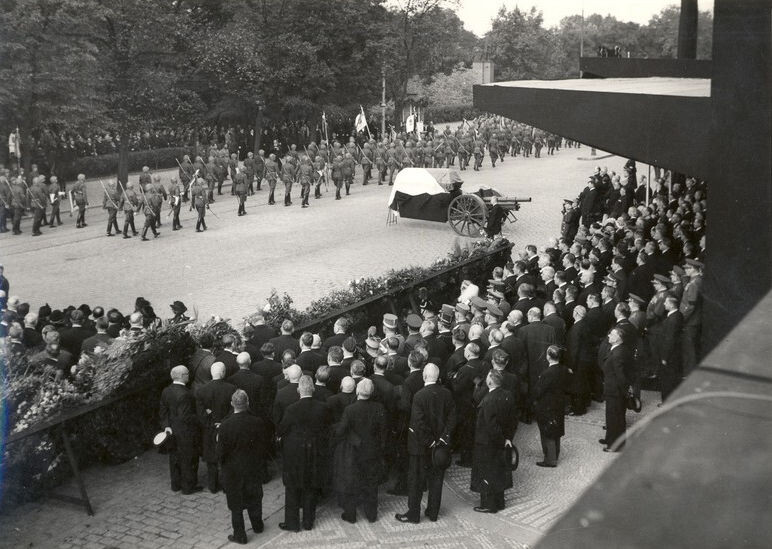A Czech Funeral. Picture, time and emotions
"At the time, the city found itself in a whirlwind of touching excitement, huge crowds of people were pushing each other to see the exposed coffin, showing great compassion ..."
Picture
The film piece, The Last Summer with TGM, was filmed by Alexander Hackenschmied and Jan Lukas during July and August 1937 about the death and funeral of Tomáš Garrigue Masaryk. Upon the death of the president the wind picks up, people in the fields and behind machines stand numb and still in a collective remembering. Without any commentary, they just do so. Funerals of important figures in Czech history are moments of rallying and collective remembrance. Whether they are captured on film as a magnificent parade of crowds, or symbolized by the image of an empty landscape, empty workplaces or candles burning in "eternal flame", the rituals manifest a solidarity with the legacy of the deceased. The spectacle that lies in the pictures of the exposed coffin and empty offices, although both meant to be admired, is slightly different. Pictures of empty cities, very different from ones of marching masses, are included as if to emphasize the invisible power of the inner spirit which has not disappeared from there. They are more pious, free from the emotional excitement of a procession.
Funeral films have all aspects of saying farewell, departure, memories of the last goodbye. The images conveyed by the funerals are the gateway to the time gap between glory and oblivion - delaying the inevitable end, they are the last opportunity to experience fellowship with the deceased. That's why they have such an intense ritual character and a symbolic overlay. Besides the fact that they document specific events and their time, they are a mostly a symbolic media that transmit and preserve the time lapse. From today’s perspective, they may seem pathetic or even naive in the repetitive reassurance of the immortality of the deceased’s work. On the other hand, they can help us understand the current popularity of live television broadcasts of funerals – even those are a pragmatic space put into space-time eternity.
And his spirit will live on forever in his work.
Time
Funeral films and broadcasts are media of time- they quickly pass, are key in the days of sadness, they are a throbbing internally restless cell in which the legacy of the late genius being buried is shaped. Edvard Beneš addressed the entire nation in his speech at the funeral of TGM "without exception, from left to right, from the last village up to the capital city, from Aša to Jasina," and called for it to continue fulfilling the legacy and work of TGM. He was building a "perfect, harmonious, socially, ethnically and politically righteous state" and to stay true to that message. With this he confirmed the collective-national dimension of the event and by emphasizing the message he referred to the symbolism that Masaryk’s person transcended. Similarly, that was the case with funerals of others- the speeches always included a summary of the legacy, usually interpreted according to the needs of the particular time. Thus, as in the case of Karel Čapek, who, in the words of Joseph Hora, left the people of turbulent times in the second republic with the following sentence: "Not all is lost, hope yet remains." The event of a funeral is as if a time lapse, three times projected all at once: the present which turns into the past and future simultaneously. The memory of the "legacy and work" calls for its maintenance by future generations. Films depicting funerals thus acquire the dimension of an eternal memory.

Few know that one of the hobbies German writer Stefan Zweig was passionate, almost obsessed with was collecting memorabilia of the great artists of his lifetime. Besides autographs, his little museum also featured everyday items connected to work. According to Zweig it "was a worldly genius embodied in a kind of moment of eternity." The idea was that he would witness a spark of creativity in the locks of hair, a writing pen and a sheet of writing paper which belonged to these masters. The need to cherish other materials aspects of artistic creation, is certainly closer to Zweig’s pre-war "world of yesterday“ of the early 20th century than to today a hundred years later. However, it has much in common with funeral films. Zweig maintained a special regard and feeling of awe towards these things and believed that through these abandoned objects and locations it was possible to find the essence of becoming or being an artist-genius of thought. It is as if the eternal spirit of the work was conserved in the emptiness of studies. The difference between the physical objectivity of the monument and the eternity of spirit become an optical illusion. If we consider films of the funerals to be void of news objectivity, let us think of the white lock of Ludwig van Beethoven’s hair (snipped on his deathbed) in Zweig's collection. In the appearance of objectivity an illusion of eternity manifests itself.
„And those will be emotions. How I am sad, I am devastated, I am chivalrous, and I am abandoned.“
Emotions
Personally, for whatever reason I have Škvorecký’s The Cowards intrinsically linked to the topic of "Czech funeral". That association is not very straightforward, but rather unusual, but not everyone will make the connection from readings this piece of work. There is no funeral in The Cowards. It is not an event in the story, but it is a recurring theme of imagination. The main hero, Danny Smiřický, imagines his own death, the pathos of his will and how the girl he desires, Irena, mourns over his coffin. This whole idea of the plot stems from his platonic love for her - "to heroically die" because he wants "Irena to be impressed." In an ingenious twist of the micro drama of imagination, however, Danny gets emotional over his own fictional funeral and turns it into a new image in which conversely he mourns at the funeral of Irene. The idea of funerals in Cowards is an ironic sump of unfulfilled desires - after a great love, heroism, compassion, it is twisted into the image of pettiness, which cowardly and out of hurt, consuming ambition is unable to transcend itself not only in a daydream but also in reality. The longing for one’s own funeral therefore encompasses something of the Czech weaknesses, as well as the desire to feel like the grieving. In piety and solemnity a foolish hope of appreciation and compassion is borne.
The section Czech Funeral of the Jihlava IDFF will feature film footage and television recordings of funerals of Czech intellectuals of the 20th century. It will primarily showcase "the eternal spirit of the nation" in the entire scope of the meaning of this phrase. It will be an opportunity to reflect on what kind of relationship we have with our intellectual elites, but also how the event of death itself and the burial of personalities leads us to a reassessment of their legacy while always taking a new look at the meaning of our history. Superficially, there is a variety of images of a procession with a coffin, a gathering around a grave, solemn speeches, then various interpretations of the national anthem and the proclamation, "the poet died", or "we will stay true". At second glance, it can lead to reflecting on what actually survived. What is the eternal message from our writers and thinkers, and does it help us understand our history better? While watching the footage, we will witness that in spite of the tragic event of a funeral, nothing really ended. Eternity will be celebrated as a soothing landscape, as a reading of wisdom and teaching, left to us by the deceased in his works.Če


